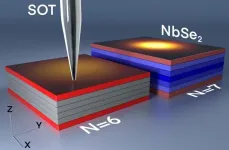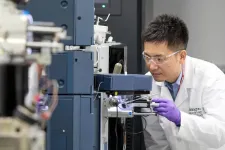(Press-News.org) Vienna, Austria- 31 March 2025 - While everybody’s heart has an absolute chonological age (as old as that person is), hearts also have a theoretical ‘biological’ age1 that is based on how the heart functions. So someone who is 50 but has poor heart health could have a biological heart age of 60, while someone of 50 with optimal heart health could have a biological heart age of 40.
Researchers presenting a new study today at EHRA 2025, a scientific congress of the European Society of Cardiology (ESC), demonstrated that by using artificial intelligence (AI) to analyse standard 12-lead electrocardiograph (ECG)2 data taken from almost half a million cases, they were able to create an algorithm to predict the biological age of the heart. This algorithm could be used to identify those most at risk of cardiovascular events and mortality.
“Our research showed that when the biological age of the heart exceeded its chronological age by seven years, the risk of all-cause mortality and major adverse cardiovascular events increased sharply,” explains Associate Professor Yong-Soo Baek, Inha University Hospital, in South Korea. “Conversely, if the algorithm estimated the biological heart as seven years younger than the chronological age, that reduced the risk of death and major adverse cardiovascular events.”
The integration of artificial intelligence (AI) into clinical diagnostics presents novel opportunities for enhancing predictive accuracy in cardiology. “Using AI to develop algorithms in this way introduces a potential paradigm shift in cardiovascular risk assessment,” says Associate Professor Baek.
Their study evaluated the prognostic capabilities of a deep learning based algorithm that calculates biological ECG heart age (AI ECG-heart age) from 12-lead ECGs, comparing its predictive power against traditional chronological age (CA) for mortality and cardiovascular outcomes.
A deep neural network was developed and trained on a substantial dataset of 425,051 12-lead ECGs collected over fifteen years, with subsequent validation and testing on an independent cohort of 97,058 ECGs. Comparative analyses were conducted among age and sex-matched patients differentiated by ejection fraction (EF).
In statistical models, an AI ECG-heart age exceeding the heart’s chronical age by seven years was associated with an increased the risk of all-cause mortality by 62% and of MACE by 92%. In contrast, an AI ECG heart age that was seven years younger than its chronological age reduced the risk of all-cause mortality by 14% and MACE by 27%.
Additionally, subjects with reduced ejection fraction consistently exhibited increased AI ECG heart ages along with prolonged QRS durations (the time taken for the heart’s electical signal to travel through the ventricles, causing contraction) and corrected QT intervals (the total time needed for the heart’s electrical system to complete one cycle of contraction and relaxation).
The authors explain that the significance of the observed correlation between reduced ejection fraction and increased AI ECG heart ages, alongside prolonged QRS durations and corrected QT intervals, suggests that AI ECG heart age effectively reflects various cardiac depolarisation and repolarisation processes. These indicators of electrical remodelling within the heart may signify underlying cardiac health conditions and their association with ejection fraction (EF). However, Associate Professor Baek explains: “It is crucial to obtain a statistically sufficient sample size in future studies to substantiate these findings further. This approach will enhance the robustness and applicability of AI ECG in clinical assessments of cardiac function and health.”
He concludes: “Biological heart age estimated by artificial intelligence from 12-lead electrocardiograms is strongly associated with increased mortality and cardiovascular events, underscoring its utility in enhancing early detection and preventive strategies in cardiovascular healthcare. This study confirms the transformative potential of AI in refining clinical assessments and improving patient outcomes.”
ENDS
Funding – the study received no external funding
Disclosures – the authors declare no conflict of interest
Notes to editors
1 - Biological age, also known as physiological or functional age, refers to how old a person’s body and its functions appear to be, based on factors like cellular damage and health status, rather than just the number of years he or she has lived.
2 - The standard 12-lead electrocardiogram is a representation of the heart's electrical activity recorded from 12 electrodes on the body surface. The electrodes are placed in certain positions to provide the most accurate picture of this electrical activity.
ESC Press Office
Tel: +33 6 61 40 18 84
Email: press@escardio.org
Follow us on X @ESCardioNews
About the European Society of Cardiology
The ESC brings together health care professionals from more than 150 countries, working to advance cardiovascular medicine and help people to live longer, healthier lives.
About the European Heart Rhythm Association
EHRA aims to improve the quality of life and reducing sudden cardiac death by limiting the impact of heart rhythm disturbances.
About EHRA 2025 #EHRA2025
Information for journalists about registration for EHRA 2025:
EHRA 2025 takes place from Sunday, March 30, to Tuesday, April 1 at Messe Wien, Messeplatz 1, 1020 Vienna, Austria. Explore the scientific programme
Free registration applies to accredited press.
Credentials: A valid press card or appropriate letter of assignment with proof of three recent published articles. Read the ESC media and embargo policy.
The ESC Press Office will verify the documents and confirm by email that your press accreditation is valid.
The ESC Press Office decision is final regarding all press registration requests.
END
Using artificial intelligence to calculate the heart’s biological age through ECG data predicts increased risk of mortality and cardiovascular events
2025-03-31
ELSE PRESS RELEASES FROM THIS DATE:
“She loves me, she loves me not”: physical forces encouraged evolution of multicellular life, scientists propose
2025-03-31
WOODS HOLE, Mass. -- Humans like to think that being multicellular (and bigger) is a definite advantage, even though 80 percent of life on Earth consists of single-celled organisms – some thriving in conditions lethal to any beast.
In fact, why and how multicellular life evolved has long puzzled biologists. The first known instance of multicellularity was about 2.5 billion years ago, when marine cells (cyanobacteria) hooked up to form filamentous colonies. How this transition occurred and the benefits it accrued to the cells, though, is less than clear.
This week, a study originating from the Marine Biological Laboratory (MBL) presents a striking example of cooperative ...
The hidden superconducting state in NbSe₂: shedding layers, gaining insights
2025-03-31
Researchers have discovered an unexpected superconducting transition in extremely thin films of niobium diselenide (NbSe₂). Published in Nature Communications, they found that when these films become thinner than six atomic layers, superconductivity no longer spreads evenly throughout the material, but instead becomes confined to its surface. This discovery challenges previous assumptions and could have important implications for understanding superconductivity and developing advanced quantum technologies.
Researchers at the Hebrew University of Jerusalem have made a surprising discovery about how superconductivity ...
New AI models possible game-changers within protein science and healthcare
2025-03-31
Researchers have developed new AI models that can vastly improve accuracy and discovery within protein science. Potentially, the models will assist the medical sciences in overcoming present challenges within, e.g. personalised medicine, drug discovery, and diagnostics.
In the wake of broadly available AI tools, most technical and natural sciences fields are advancing rapidly. This is particularly true in biotechnology, where AI models power breakthroughs in drug discovery, precision medicine, gene editing, food security, and many other research areas.
One sub-field is proteomics – the study of proteins on a large scale – where ...
Highly accurate blood test diagnoses Alzheimer’s disease, measures extent of dementia
2025-03-31
A newly developed blood test for Alzheimer’s disease not only aids in the diagnosis of the neurodegenerative condition but also indicates how far it has progressed, according to a study by researchers at Washington University School of Medicine in St. Louis and Lund University in Sweden.
Several blood tests for Alzheimer’s disease are already clinically available, including two based on technology licensed from WashU. Such tests help doctors diagnose the disease in people with cognitive symptoms, but do not indicate the ...
Mind the seismic gap: Understanding earthquake types in Guerrero, Mexico
2025-03-31
Plate temperature and water release can explain the occurrence of different types of earthquakes in Guerrera, Mexico. The Kobe University simulation study also showed that the shape of the Cocos Plate is responsible for a gap where earthquakes haven’t occurred for more than a century. The results are important for accurate earthquake prediction models in the region.
Where one tectonic plate is pushed down by another, the resulting stress is released in various tectonic events. There are catastrophic megathrust earthquakes, unnoticeable “slow slip events,” and continuous low-frequency “tectonic tremors,” and knowing ...
One hour’s screen use after going to bed increases your risk of insomnia by 59%, scientists find
2025-03-31
Scientists have found another reason to put the phone down: a survey of 45,202 young adults in Norway has discovered that using a screen in bed drives up your risk of insomnia up by 59% and cuts your sleep time by 24 minutes. However, social media was not found to be more disruptive than other screen activities.
“The type of screen activity does not appear to matter as much as the overall time spent using screens in bed,” said Dr Gunnhild Johnsen Hjetland of the Norwegian Institute of Public Health, ...
Canada needs to support health research at home and abroad
2025-03-31
In the face of major changes to federal policy and funding in the United States, Canada should support Canadian researchers with adequate funding to ensure long-term research in health and science, argue authors in two articles published in CMAJ (Canadian Medical Association Journal).
“As the US stands on the brink of tearing down its exemplary system for covering the full costs of research, Canada, with its flawed federal system for indirect costs, should heed the recent commissioned science policy report and a chorus of advocacy calling for an enhanced indirect cost system,” writes Dr. William Ghali, vice-president ...
Cannabis use disorder among insured pregnant women in the US between 2015-2020
2025-03-31
Cannabis use has been increasing during pregnancy, according to researchers at Columbia University Mailman School of Public Health and the Columbia University Irving Medical Center. Previous research has observed that past-month cannabis use has more than tripled among pregnant women in the U.S. from 2002-2020 with self-reported cannabis use rising from 1.5 percent to 5.4 percent over the 18 years of tracking data. The findings are published in the American Journal of Preventive Medicine.
Medical guidelines recommend that pregnant women abstain from cannabis because of its link to an increased risk of adverse maternal ...
Education system needs overhaul to support school anxiety, psychologists say
2025-03-30
The UK education system must urgently change to be more understanding of school ‘refusers’, as returning to school might not be the right outcome for some children, psychologists say.
While much has been made of school attendance figures in recent months, a group of experts are suggesting not enough attention has been given to the experiences of parents and young people experiencing school distress.
In a new book, What Can We Do When School’s Not Working?, a parent and two ...
Play “humanizes” pediatric care and should be key feature of a child-friendly NHS – report
2025-03-30
Play should be a core feature of children’s healthcare in forthcoming plans for the future of the NHS, according to a new report which argues that play “humanises” the experiences of child patients.
The report, by University of Cambridge academics for the charity Starlight, calls for play, games and playful approaches to be integrated into a ‘holistic’ model of children’s healthcare – one that acknowledges the emotional and psychological dimensions of good health, ...



